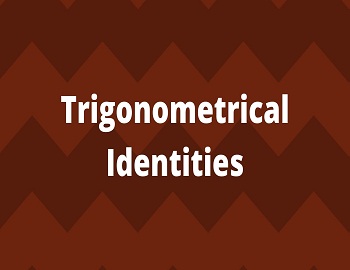Trigonometrical Identities:
An equation involving trigonometric ratios of an angle θ (say), which is true for all values of θ for which the given trigonometric ratios are defined, is called trigonometric identities.

The situation is exactly similar to algebraic identity viz; (a +b)2 = a2+ 2ab + b2 which is true for all values of a and b.
Example I- cos2 θ – 1/2 cos θ = cos θ (cos θ – 1/2) is a trigonometric identity, whereas cos θ (cos θ – 1/2) = 0 is an equation.
Example II- cosec θ = 1/sinθ is a trigonometric identity because it holds for all values of θ except for which sin θ = 0.
For sin θ = 0, cosec θ is not defined.
Now we shall establish the following two theorems which form the backbone of any trigonometrical identity.
| Theorem I: For any acute angle θ, prove that the following identities- (i) sin2 θ + cos2 θ = 1 (ii) 1 + tan2 θ = sec2 θ (iii) 1 + cot2 θ = cosec2 θ. Proof: Suppose an acute angle ∠XAY = θ has been given. Take a point P on AY. Draw PM ⊥ AX. In right-angled triangle AMP, let Base = AM = x, Perepndicular = PM = y and Hypotenuse = AP = r. Then, by the Pythagoras theorem, we have x2 + y2 = r2. Now (i) sin2 θ + cos2 θ = (y/r)2 + (x/r)2 = y2/r2 + x2/r2 = y2+x2/r2 = r2/r2 = 1 [∵ x2 + y2 = r2] Hence sin2 θ + cos2 θ = 1. (ii) 1 + tan2 θ = 1 + (y/x)2 = 1 + y2/x2 = x2+y2/x2 = r2/x2 = (r/x)2 = sec2 θ [∵ x2 + y2 = r2] Hence 1 + tan2 θ = sec2 θ. (iii) 1 + cot2 θ = 1 + (x/y)2 = 1 + x2/y2 = y2+x2/y2 = r2/y2 = (r/y)2 = cosec2 θ [∵ x2 + y2 = r2] Hence 1 + cot2 θ = cosec2 θ. |
| Theorem II: For any acute angle θ, prove the identities: (i) tan θ = sin θ/cos θ (ii) cot θ = cos θ/sin θ (iii) tan θ cot θ = 1. Proof: As given in the above figure, we have (i) tan θ = y/x = (y/r)/(x/r) = sin θ/cos θ [Dividing numerator and denominator by r] ∴ tan θ = sin θ/cos θ. (ii) cot θ = x/y = (x/r)/(y/r) = cos θ/sin θ [Dividing numerator and denominator by r] ∴ cot θ = cos θ/sin θ. (iii) tan θ cot θ = y/x . x/y = 1 ∴ tan θ cot θ = 1. |
Important: As a consequence of the identities given in theorem I, we have-
(i) 1 – sin2 θ = cos2 θ and 1 – cos2 θ = sin2 θ.
(ii) sec2 θ – tan2 θ = 1 and sec2 θ – 1 = tan2 θ.
(iii) cosec2 θ – cot2 θ = 1 and cosec2 θ – 1 = cot2 θ.
Since the proofs of identities of theorem I involve Pythagoras Theorem, they are called Pythagorean identities.
The identity sin2 θ + cos2 θ = 1 tells us that the point P with coordinates (cos θ, sin θ) lies on the unit circle x2 + y2 = 1, i.e., the circle with origin as the centre and unity as the radius.

Since by definition, cos θ and sin θ are both non-negative i.e., ≥ 0 for 0° ≤ θ ≤ 90°, P is in the first quadrant of the circle. Conversely, if we take a point P in the first quadrant of the unit circle, then the coordinates of P are (OM, MP) i.e., (OM/OP, MP/OP), since OP = 1 i.e., (cos θ, sin θ) where θ is the angle XOP.
It is for this reason that the trigonometric ratios cos θ and sin θ are also called circular functions.









Comments (No)